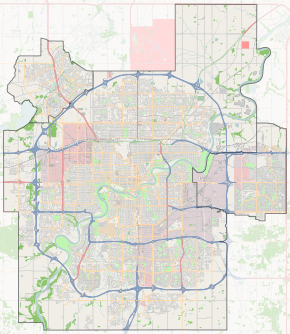Highlands, Edmonton
| Highlands | |
|---|---|
| Neighbourhood | |
 Highlands Location of Highlands in Edmonton | |
| Coordinates: 53°33′58″N 113°25′55″W / 53.566°N 113.432°W | |
| Country |
|
| Province |
|
| City | Edmonton |
| Quadrant[1] | NW |
| Ward[1] | 7 |
| Sector[2] | Mature area |
| Government[3] | |
| • Administrative body | Edmonton City Council |
| • Councillor | Tony Caterina |
| Area[4] | |
| • Total | 1.15 km2 (0.44 sq mi) |
| Elevation | 662 m (2,172 ft) |
| Population (2012)[5] | |
| • Total | 2,631 |
| • Density | 2,287.8/km2 (5,925/sq mi) |
| • Change (2009–12) |
|
| • Dwellings | 1,346 |
Highlands is a residential neighbourhood in north east Edmonton, Alberta, Canada overlooking the North Saskatchewan River valley. The area was annexed by Edmonton in 1912, and "was named in a contest offering a 50-dollar prize." [6] In 2012, Highlands was ranked one of Canada's top ten neighbourhoods of old homes by the magazine This Old House.[7]
The neighbourhood is bounded on the north by 118 (Alberta) Avenue, on the east by 50 Street, on the west by 67 Street, and on the south by the North Saskatchewan River valley. Interchanges between Wayne Gretzky Drive and both 118 Avenue and 112 Avenue give residents access to destinations south of the river including Whyte Avenue and the University of Alberta.
Residents also have access to Northlands, the Coliseum, Commonwealth Stadium and Concordia College. All four facilities are located a short distance west of the neighbourhood.
Demographics
In the City of Edmonton's 2012 municipal census, Highlands had a population of 2,631 living in 1,346 dwellings,[5] a 4.4% change from its 2009 population of 2,520.[8] With a land area of 1.15 km2 (0.44 sq mi), it had a population density of 2,287.8 people/km2 in 2012.[4][5]
Residential development
Highlands is an older Edmonton neighbourhood. According to the 2001 federal census, approximately one residence in three (31.3%) were built by the end of World War II in 1945. Half the residences (47.2%) were built between 1946 and 1960. Another one in eight residences were built between 1961 and 1980. By 1990, residential development was substantially complete.[9]
The most common type of residence in the neighbourhood, according to the 2012 municipal census, is the single-family dwelling. Single family dwellings account for nine out of every ten (90%) of all the residences in the neighbourhood. One out of every fourteen residences is a rented apartment in a low-rise building with fewer than five stories. Rounding out the residences are a small number (2%) of duplexes.[10] Four out of every five residences (81%) are owner-occupied with only one residence in five (19%) being rented.[11]
Schools

There are two schools in the neighbourhood, Highlands Public School and Mount Royal Elementary School, both operated by the Edmonton Public School System.
Notable residents
Marshall McLuhan, recipient of numerous awards and appointments and a pioneer of media theory[12] was born in Edmonton and spent his formative years living with his family in the Highlands neighbourhood. He would recall memories of the first home in which he lived and the expanse of the adjacent river valley, and his early explorations of visual perspective as a fundamental artistic and communicational principle.[13] Computer scientist (and early Google investor) David Cheriton grew up in the area and attended public schools.[14] There is a children's garden and memorial stone, dedicated to Trooper Michael Yuki Hayakaza, a Highlands community member who was killed during a military tour of duty in Afghanistan. The memorial stone is located at the foot of the children's play park.[15]
Surrounding neighbourhoods
 |
Montrose | Montrose, Newton | Beacon Heights |  |
| Bellevue | |
Beverly Heights | ||
| ||||
| | ||||
| North Saskatchewan River | North Saskatchewan River | North Saskatchewan River |
http://www.cbc.ca/news/canada/edmonton/story/2010/09/19/edm-highlands-soldier-tribute-hayakaze.html cbc
References
- 1 2 "City of Edmonton Wards & Standard Neighbourhoods" (PDF). City of Edmonton. Retrieved February 13, 2013.
- ↑ "Edmonton Developing and Planned Neighbourhoods, 2011" (PDF). City of Edmonton. Retrieved February 13, 2013.
- ↑ "City Councillors". City of Edmonton. Retrieved February 13, 2013.
- 1 2 "Neighbourhoods (data plus kml file)". City of Edmonton. Retrieved February 13, 2013.
- 1 2 3 "Municipal Census Results – Edmonton 2012 Census". City of Edmonton. Retrieved February 22, 2013.
- ↑ From the neighbourhood description in the City of Edmonton Map Utility.
- ↑ "HHighlands recognized as top 10 neighbourhoodighlands recognized as top 10 neighbourhood". Edmonton Journal. 2 March 2012. Retrieved 2014-01-24.
- ↑ "2009 Municipal Census Results". City of Edmonton. Retrieved February 22, 2013.
- ↑ http://censusdocs.edmonton.ca/DD23/FEDERAL%202001/Neighbourhood/HIGHLANDS.pdf
- ↑ Duplexes include triplexes and quadruplexes.
- ↑ http://censusdocs.edmonton.ca/C05002/MUNICIPAL%202005/Neighbourhood/HIGHLANDS.pdf
- ↑ CBC. "Marshall McLuhan". CBC News. http://archives.cbc.ca/arts_entertainment/media/topics/342/.
- ↑ http://www.uofaweb.ualberta.ca/mact/pdfs/UofACOMMbrochure09.pdf
- ↑ "Just an 'ordinary' hometown billionaire: Edmonton's wealthiest son is hardly a household name, and the Google billionaire couldn't care less". The Edmonton Journal. April 3, 2006. Retrieved June 25, 2011.
- ↑ http://www.cbc.ca/news/canada/edmonton/edmonton-community-honours-fallen-soldier-1.938630
External links
- Census 2012 http://www.edmonton.ca/city_government/documents/Highlands.pdf
- Highlands Community League
- Highlands Historical Society
- Mount Royal Elementary School and memories of Highlands
- Highlands Junior High School